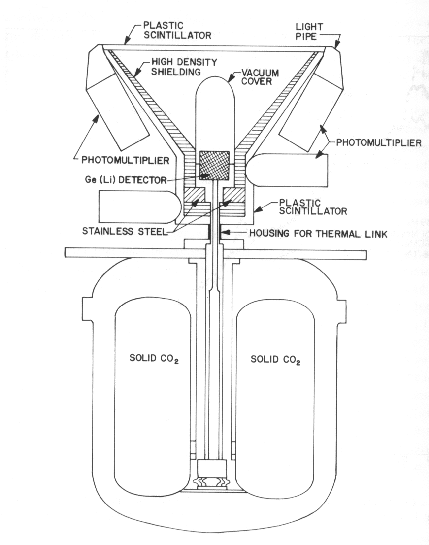Radsat
 Mission Overview
Mission Overview
The spin stabilized satellite Radsat was launched by the US Air Force on
2 October 1972 into a noon-midnight, Sun-synchronous orbit. The satellite is
sometimes referred to as 1972-076B (its international launch number) or
P72-1. The inclination was 98.4 degrees; the apogee and perigee were 761 and
736 km, respectively. The cylindrical spacecraft was 2.13 m long and 1.37 m in
diameter. Antenna booms extended 2.74 m from each end, coincident with the
spin axis. The orbital period was 99.5 minutes, and the spin period was 5 s.
The satellite carried 5 instruments: a gamma-ray spectrometer, an extreme
ultraviolet detector, 2 low-altitude particle detectors, and a thermocontrol
coating test instrument. The satellite is not expected to decay into the
atmosphere until the year 2012. The gamma-ray instrument, however, ceased
function after ~7 months.
 Instrumentation
Instrumentation
The gamma-ray detector was a 50 cubic-cm Ge(Li) spectrometer with an active
area of 15 sq-cm. It was cooled by solid CO2. The detector was surrounded by a
W collimator and a stainless steel tungsten rear shield, which was in turn
surrounded by a 4-pi anticoincidence plastic scintillator. The detector
covered the energy range 40 keV - 2.8 MeV, with 4096 channels. The maximum
resolution was ~ 4 keV (FWHM) at all energies. However, this resolution was
short-lived, and during most of the lifetime of the experiment the
resolution was between 10 - 50 keV. Data were accumulated in 1-ms time bins
during a burst. This instrument represented the first high-resolution
germanium spectrometer flown on a satellite.

 Science
Science
Several gamma-ray bursts which were also seen by the Vela satellites were
seen by Radsat. A ~60-ms microburst was seen prior to the Vela trigger
time for the 18 December 1972 event. Furthermore, the spectrum was seen to
soften in this event at later times.
 Other information
Other information
- Imhof et al, 1974, Ap J Lett, 191, L7-L10.
- Imhof et al., 1975, Ap J, 198, pp. 717-725.
- E.L. Chupp, Gamma-Ray Astronomy, pp. 238-242.
- The RAE Table of Earth Satellites 1957-1982.
